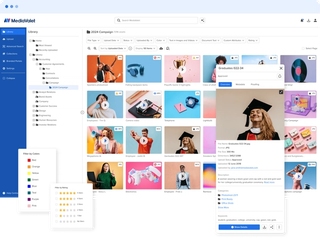DAM Knowledge
What is MAM? Key Differences Between MAM and DAM

Carlie Hill
Director of Growth Marketing
6 min read

What is MAM? And what is the difference between a MAM and a DAM? Making the right choice, requires an in-depth understanding of the definitions and differences between each system. This knowledge is crucial to selecting the appropriate solution for your business.
Both digital asset management software and media asset management software allow organizations to manage digital assets, but their functionalities and integrations set them apart.
While we've already covered the major differences between DAM and CMS or a file-sharing platform, it's time to tackle another asset management solution. Here. we'll cover what is MAM? and we'll compare digital asset management vs. media asset management.
In this blog post, we dive into the key differences between DAM and MAM and help you discover which is the best asset management software for your organization.
Since its inception, digital asset management software (DAM) and media asset management software (MAM) have often been referenced interchangeably. After all, with only a one-word difference between their names, it can be easy to confuse the two. But, while their names, and even definitions, are similar, their functionality is tailored to very different markets.
To understand the difference between the asset management tools, a good starting point is to look at the definition of each:
Media Asset Management Definition
Media asset management software is an online platform used to organize, store, and manage rich media, and digital rights and permissions.
A MAM is used to manage and distribute large-sized media files, typically focusing on time-based assets like videos and audio. It’s most frequently used by the broadcast industry to manage large video clips.
Digital Asset Management Definition
A DAM is used to organize and distribute media, visuals and content, typically focused on brand and marketing-related assets. It’s usually owned by the marketing team but can be accessed by multiple teams, including sales, product management, communications, and partners.
Let’s take a look at each solution more in-depth!
Digital Asset Management vs. Media Asset Management: The Key Differences
According to Firework, 82% of internet traffic in 2025 will be video, making it increasingly important for organizations to effectively organize and manage their growing libraries of rich digital media assets.
This has caused a variety of solutions to emerge, ranging from simple file repositories to enterprise-level digital libraries. But, with each vendor offering similar-sounding features, it can be difficult to nail-down which solution is right for you.
Let's break down the differences between MAM software and DAM software.

What is MAM?
Media asset management originally emerged as a solution for managing video files and audio content for the television and movie industry. With production and distribution workflows focused specifically on building long-form (20 minutes or more), time-based content, it's often the solution of choice for organizations dealing primarily with large-sized videos. As MAMs focus primarily on video, they also often have the most comprehensive integrations into the tools that video production teams are already using.
ImagenVP defines media asset management software (MAM) as:
“A single repository for storing and managing video and multi-media files.”
While a MAM provides in-depth management of video, it’s lacking the ability to effectively manage, preview and distribute smaller files, like documents, images and work-in-progress files. This means that, while it’s a great solution for production teams, it’s less viable for marketing and creative teams, who require the wider breadth of management capabilities that a DAM can provide.
Key Features of Media Asset Management Software
A media asset management solution has a ton of features, but its key features are:
- Storing and managing large-format video, audio files, and multimedia files
- Workflow management for video creation
- Providing permission-based access to content
The Bottom Line
Media asset management software (MAM) is best for teams with a heavy focus on long-form video and audio content and a large media asset library, with minimal use of other visuals, like images and design files.
What is DAM?
A digital asset management system is an integral part of the media content creation process, helping marketing teams organize, collaborate on and distribute their rich media files and visual media from within one central library. By providing a single-source-of-truth for all the important visual content within an organization, a DAM reduces internal bottlenecks and improves brand consistency across all channels.
TechTarget defines digital asset management software (DAM) as:
“A system for organizing, storing and retrieving rich media and managing digital rights and permissions.”
With a DAM, users can manage nearly any type of digital file. From within the system, users can perform a variety of functions, including re-sizing & re-formatting their media, tracking usage history and sharing large files easily with external parties. A DAM also provides organizations with increased media security, such as user permissions, compliance regulations and backups.
Key Features of Digital Asset Management Software
At first glance, a DAM can seem similar to a MAM, but it has some differentiating features:
- Storing and managing brand and marketing material (photos, videos, video and multimedia files, etc.)
- Enriching assets with custom AI-generated metadata, such as keywords
- Version control and history tracking for all media assets
- Manipulating assets into other forms, such as file type or size
- Access permissions for internal and external users
- Video Intelligence (AVI) to automatically tag, recognize, and transcribe media rich files.

Why choose a MediaValet DAM?
MediaValet customers find that DAM has been able to satisfy their light-MAM requirements through our video specific feature sets and support, including:
- CI HUB enabling creatives and video editors to easily connect to their DAM library from within a variety of tools including Adobe Premiere Pro and After Effects
- A high performing, infinitely scalable Azure PaaS back-end, ensuring persistent lightning-fast ingestion and querying of video assets, regardless of library size
- World-class support for viewing, streaming, and transforming video, leveraging Azure Media Services
- Audio & Video Intelligence tool (Built on Azure Video Analyzer)
According the 2025 DAM Trends Report, MediaValet users who use AI-powered features like AVI are seeing big benefits in their rich asset management.
In fact 100% of those using Video Intelligence are expanding their digital presence.
While a DAM provides great functionality for managing a wide breadth of digital assets, including video, its video capabilities are evolving and enhancing through AI-powered technology.
Fred Rogers Productions have used their MediaValet DAM's audio-visual intelligence (AVI) to achieve incredible results with their huge repository of video! Read more about it here.

The Bottom Line
Whether you're leaning towards DAM or MAM, the most crucial aspect is understanding your organization's unique needs. Efficiently managing your digital assets can transform your operations, ensuring content is always at your fingertips.
A DAM is best for companies that need a better way to produce, store, collaborate on, share and distribute large amounts of marketing and creative content (photos, videos, audio, etc.)
Does a DAM sound like a better fit than MAM? Contact us today to find out how a MediaValet DAM can help your organization - book a demo here!
MediaValet is a leader in cloud-based digital asset management that helps organizations manage, organize and share their digital assets, improving productivity and increasing ROI.
Related articles




